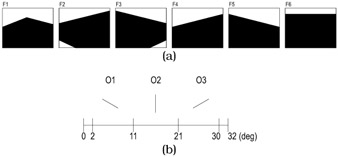6. Playfield Zone Classification
6. Playfield Zone Classification
The soccer playfield has been divided in 12 zones, 6 for each side (Figure 5.14). These zones have been chosen so that the change from one to the other indicates a change in the action shown, such as a defense action that changes into a counter-attack, or an attack that enters the goal box. Moreover it must be noted that typical camera views are associated with the selected zones. In some cases the zones can't be recognized from simple image analysis (e.g., zones near the center of the playfield), but the temporal analysis solves this problem.

Figure 5.14: Playfield zones; Z7 to Z12 are symmetrical.
The features used to recognize the playfield zones are playfield lines and the playfield shape. Figure 5.15 shows an example of extraction of playfield shape and playfield lines. From these features we calculate a five elements vector composed by the following elements:
-
playfield shape descriptor F: six different views of the playfield are recognized. They are shown in Figure 5.16 a);

Figure 5.16: (a) Playfield shape descriptor F. (b) Playfield line orientation descriptor O. -
playfield line orientation descriptor O: playfield lines are extracted, and their directions are quantized in 32 bins. These bins are grouped to calculate the number of horizontal and vertical lines, and the number of lines whose angle is greater or smaller than the specified line orientation descriptor, as shown in Figure 5.16 b);
-
playfield size descriptor R: this descriptor signals if the percentage of pixels of a frame, that belong to the playfield, is above a threshold;
-
playfield corner position C: this descriptor may assume 4 values: absence of playfield corner in the image, or presence of one of three possible positions of the playfield corner that is farthest from the camera, as shown in Figure 5.17 a);

Figure 5.17: (a) Playfield corner position descriptor C. (b) Midfield line descriptor M. -
midfield line descriptor M: this descriptor is similar to the C descriptor, but it indicates the presence and type of the midfield line (Figure 5.17b).

Figure 5.15: Original image, playfield shape and lines in soccer.
A Na ve Bayes classifier has been used to classify each playfield zone Zx. This choice is motivated by the fact that: i) we are interested in confidence values for each zone, to handle views that are not easily classified; ii) some descriptors are not useful for some zones (e.g., the C descriptor is not useful for the midfield zone); iii) some zones are mutually exclusive and some are not, thus it is not possible to define them as different values of a single variable. In Figure 5.18 the classifiers for Z1 and Z6 are shown. It must be noted that in some cases some values of the descriptors correspond to a single value of the variable of the classifier, e.g.,:


Figure 5.18: Na ve Bayes networks— Z1 and Z6 zone classifiers.
Playfield zone classification is performed through the following steps: playfield lines and shape are extracted from the image, descriptors are then calculated and the observation values of the classifier variables are selected. The classifier with the highest confidence value (if above a threshold) is selected.
EAN: 2147483647
Pages: 393